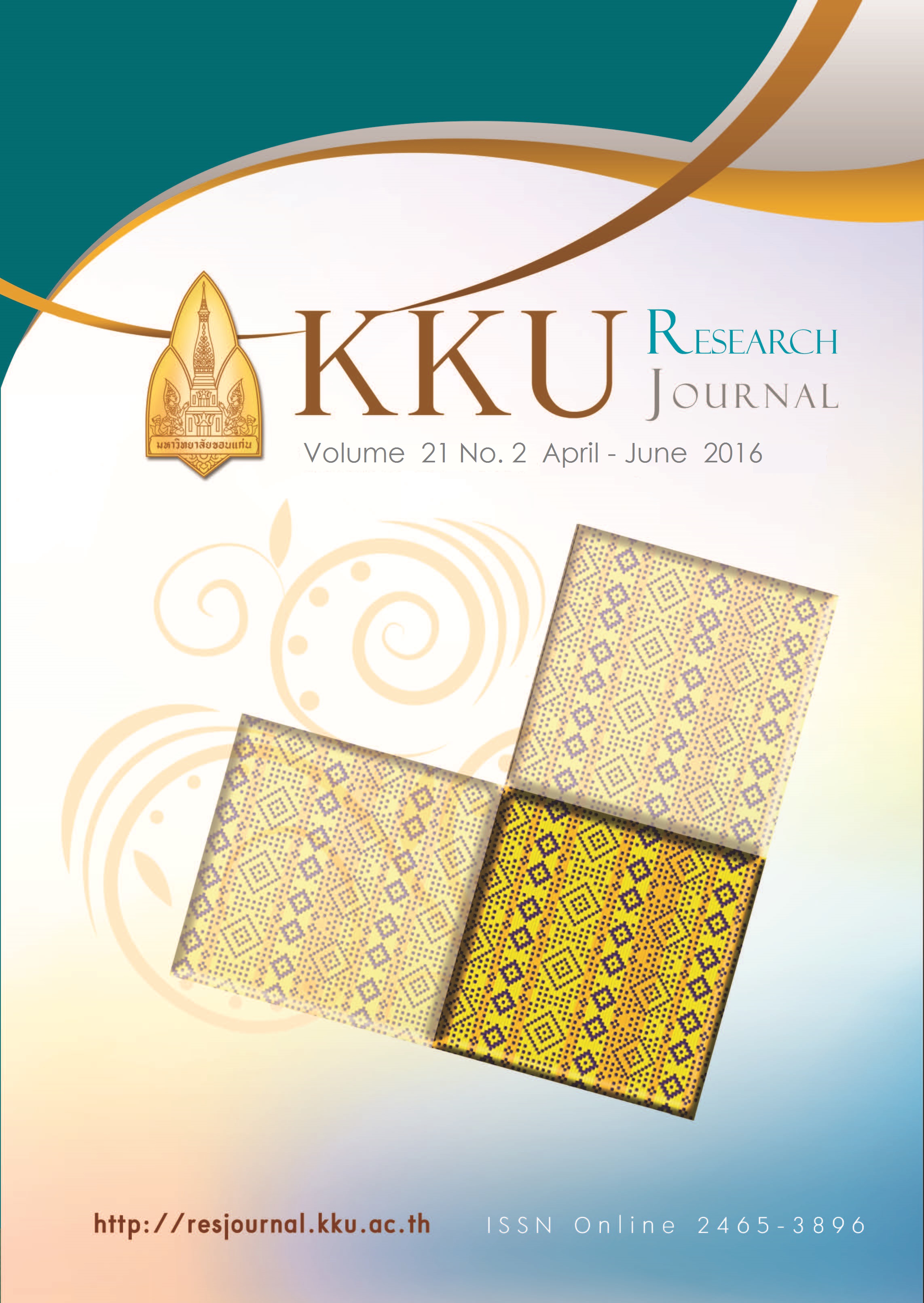Preparation the substrate from palmyra palm fruit by candida stellimalicola fermentation for acetic acid production
Main Article Content
Abstract
The ripe palmyra palm or toddy palm (Borassus flabellifer Linn.) has the yellow-orange pulp with proximate pH 4.47-5.1 and total soluble solid 5.01±0.15 oBrix. In this research, the yeast Candida stellimalicola isolated from the ripe palm fruit pulp was used to ferment the palm fruit juice to ethanol and applied into acetic acid production. The effects of ammonium sulphate as the nitrogen source and sugars (glucose and sucrose) as the carbon source on ethanol fermentation were investigated. The ammonium sulphate concentrations at 300, 500 and 700 mg/L significantly increased the produced ethanol content (p<0.05). The supplementation of 500 mg/L ammonium sulfate gave the highest ethanol content at 5.75±0.09% after 7 days. The palmyra palm fruit juice was adjusted into 10 oBrix and 15 oBrix by sucrose and glucose addition for fermentation at 30oC and shaking condition within 7 days. There was a significant difference in the ethanol content between glucose and sucrose (p<0.05). In addition, 10 and 15 oBrix glucose showed the ethanol content with 5.43±0.13 and 5.40±0.44%, respectively (p>0.05). Whereas, using 10 oBrix sucrose showed the ethanol content with 1.82±0.45 and closely to 15 oBrix (1.70±0.41%). For scale up at 6 liters, the fermentation of palmyra palm fruit juice with 10 oBrix glucose and 500 mg/L ammonium sulfate supplementation was carried out at room temperature (31±2oC) and 300 rpm/min. As the results, the ethanol content was approximately 3.92±0.15% after 14 days. In the future this product will be used for acetic acid production.
Article Details
References
[2] Ariyasena, D.D., Jansz, E.R. and Abeysekera, A.M. Some studies directed at increasing the potential use of palmyrah (Borassus flabellifer L.) fruit pulp. Journal of t h e S c i e n c e o f F o o d a n d Agriculture. 2001; 81: 1347-1352.
[3] Bafrncova, P., Smogrovicova, D.,Slavikova, I., Patkova, J. and Domeny, Z. Improvement of very high gravity ethanol fermentation by media supplementation using Saccharomyces cerevisiae . Biotechnology Letters. 1999; 21:337-341.
[4] Coleman, M.C., Fish, R. and Block, E.D. Temperture - dependent kinetic model for nitrogen limited wine fermentation. Applied and Environmental Microbiology. 2007;73(18): 5878-5884.
[5] Jansz, E.R., Nikawela, J.K.,Gooneratne, J. and Theivendirarajah, K. Studies on the bitter Principle and debittering of palmyrah fruit pulp. Journal of Science of Food and Agriculture. 1994; 65: 185-189.
[6] Leuangnapa, N. Production of palmyra palm (Borassus flabillifer Linn.) powder and its uses in some Thai desserts. Bangkok, Thailand: Kasetsart University, MSc. Thesis.1990.
[7] Nantitanon, W. Effects of ammoniacal nitrogen addition in wine fermentation. Chiang Mai, Thailand: Chiang Mai University. MSc. Thesis. 2006.
[8] Nikawela, J.K., Abeysekara, A.M. and Jansz, E.R. Flabelliferinssteroidal saponins from palmyrah (Borassus flabellifer L.) Isolation b y f l a s h c h r o m a t o g r a p h y quantififation and saponin related activity. Journal of the National Science Council Sri Lanka. 1998; 26: 9-18.
[9] Nikawela, J.K., Wijeyaratne. S.C., Jansz, E.R. and Abeysekara, A.M. Flabelliferins- steroidal saponins from palmyrah (Borassus flabellifer L.) II. Preliminary investigations of effect on yeast and selected bacteria. Journal of the National Science Council Sri Lanka. 1998; 26: 141-150.
[10] Pramanik, K., and D.E. Rao. K i n e t i c s t u d y o n e t h a n o l fermentation of grape waste using Saccharomyces cerevisiae yeast isolated from toddy. The Institution o f E n g i n e e r s ( I n d i a ) Publications.2005; 85: 53-58.
[11] T h e i v e n d i r a r a j a h , K . a n d Chrystopher, R. K. Alcohol from palmyrah palm (BORASSUS FLABELLIFER L.) fruit pulp. Vingnanam Journal of Science. 1986; 1: 44-46.


